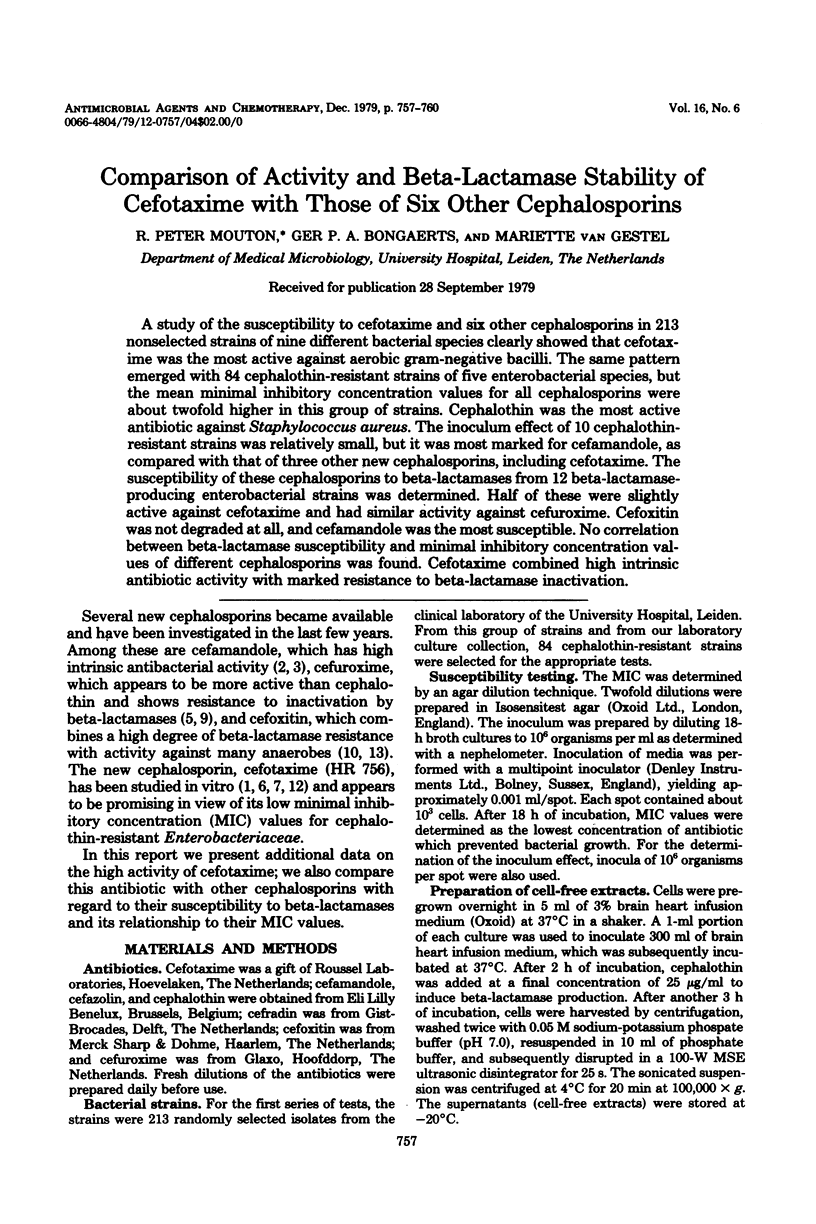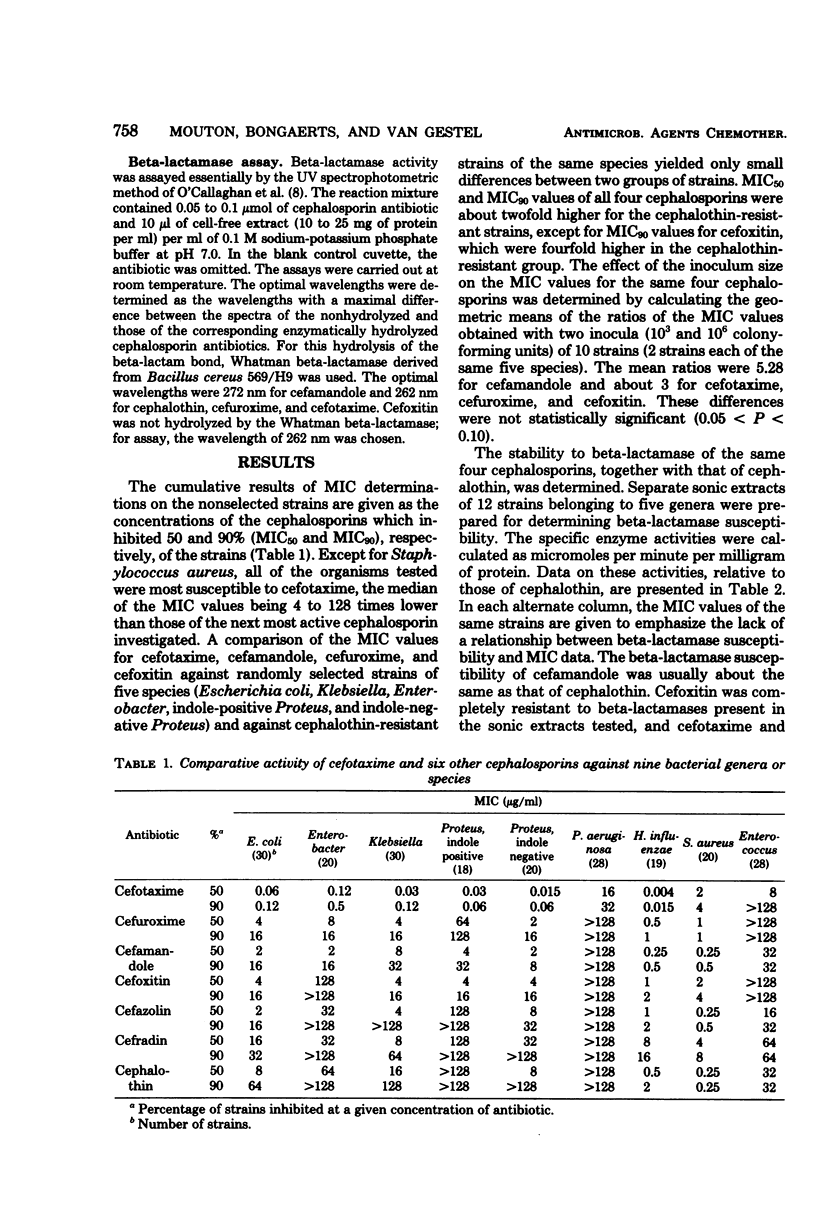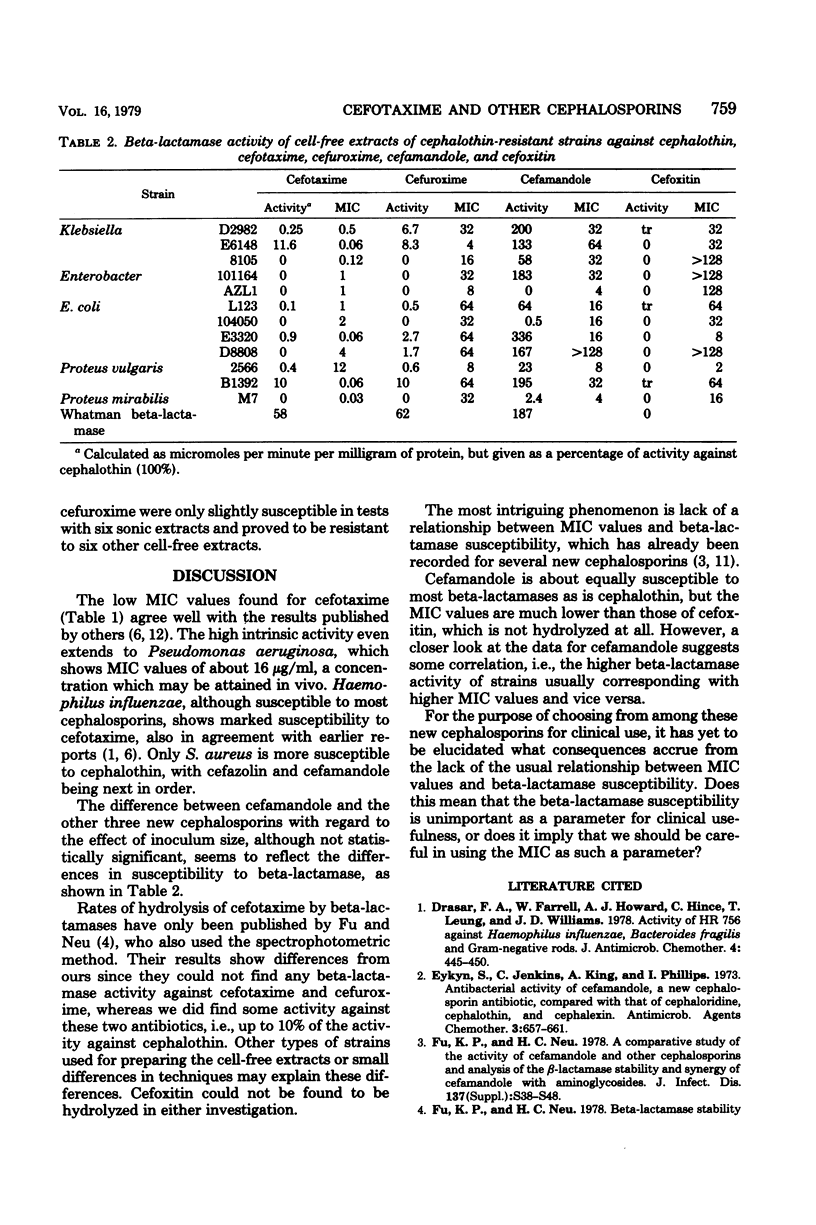Abstract
A study of the susceptibility to cefotaxime and six other cephalosporins in 213 nonselected strains of nine different bacterial species clearly showed that cefotaxime was the most active against aerobic gram-negative bacilli. The same pattern emerged with 84 cephalothin-resistant strains of five enterobacterial species, but the mean minimal inhibitory concentration values for all cephalosporins were about twofold higher in this group of strains. Cephalothin was the most active antibiotic against Staphylococcus aureus. The inoculus effect of 10 cephalothin-resistant strains was relatively small, but it was most marked for cefamandole, as compared with that of three other new cephalosporins, including cefotaxime. The susceptibility of these cephalosporins to beta-lactamases from 12 beta-lactamase-producing enterobacterial strains was determined. Half of these were slightly active against cefotaxime and had similar activity against cefuroxime. Cefoxitin was not degraded at all, and cefamandole was the most susceptible. No correlation between beta-lactamase susceptibility and minimal inhibitory concentration values of different cephalosporins was found. Cefotaxime combined high intrinsic antibiotic activity with marked resistance to beta-lactamase inactivation.
Full text
PDF



Selected References
These references are in PubMed. This may not be the complete list of references from this article.
- Drasar F. A., Farrell W., Howard A. J., Hince C., Leung T., Williams J. D. Activity of HR 756 against Haemophilus influenzae, Bacteroides fragilis and Gram-negative rods. J Antimicrob Chemother. 1978 Sep;4(5):445–450. doi: 10.1093/jac/4.5.445. [DOI] [PubMed] [Google Scholar]
- Eykyn S., Jenkins C., King A., Phillips I. Antibacterial activity of cefamandole, a new cephalosporin antibiotic, compared with that of cephaloridine, cephalothin, and cephalexin. Antimicrob Agents Chemother. 1973 Jun;3(6):657–661. doi: 10.1128/aac.3.6.657. [DOI] [PMC free article] [PubMed] [Google Scholar]
- Fu K. P., Neu H. C. A comparative study of the activity of cefamandole and other cephalosporins and analysis of the beta-lactamase stability and synergy of cefamandole with aminoglycosides. J Infect Dis. 1978 May;137 (Suppl):S38–S50. doi: 10.1093/infdis/137.supplement.s38. [DOI] [PubMed] [Google Scholar]
- Greenwood D., Pearson N. J., O'Grady F. Cefuroxime: a new cephalosporin antibiotic with enhanced stability to enterobacterial beta-lactamases. J Antimicrob Chemother. 1976 Dec;2(4):337–343. doi: 10.1093/jac/2.4.337. [DOI] [PubMed] [Google Scholar]
- Hamilton-Miller J. M., Brumfitt W., Reynolds A. V. Cefotoxime (HR 756) a new cephalosporin with exceptional broad-spectrum activity in vitro. J Antimicrob Chemother. 1978 Sep;4(5):437–444. doi: 10.1093/jac/4.5.437. [DOI] [PubMed] [Google Scholar]
- Neu H. C., Aswapokee N., Aswapokee P., Fu K. P. HR 756, a new cephalosporin active against gram-positive and gram-negative aerobic and anaerobic bacteria. Antimicrob Agents Chemother. 1979 Feb;15(2):273–281. doi: 10.1128/aac.15.2.273. [DOI] [PMC free article] [PubMed] [Google Scholar]
- O'Callaghan C. H., Sykes R. B., Griffiths A., Thornton J. E. Cefuroxime, a new cephalosporin antibiotic: activity in vitro. Antimicrob Agents Chemother. 1976 Mar;9(3):511–519. doi: 10.1128/aac.9.3.511. [DOI] [PMC free article] [PubMed] [Google Scholar]
- Onishi H. R., Daoust D. R., Zimmerman S. B., Hendlin D., Stapley E. O. Cefoxitin, a semisynthetic cephamycin antibiotic: resistance to beta-lactamase inactivation. Antimicrob Agents Chemother. 1974 Jan;5(1):38–48. doi: 10.1128/aac.5.1.38. [DOI] [PMC free article] [PubMed] [Google Scholar]
- Ott J. L., Turner J. R., Mahoney D. F. Lack of correlation between beta-lactamase production and susceptibility to cefamandole or cefoxitin among spontaneous mutants of Enterobacteriaceae. Antimicrob Agents Chemother. 1979 Jan;15(1):14–19. doi: 10.1128/aac.15.1.14. [DOI] [PMC free article] [PubMed] [Google Scholar]
- Sosna J. P., Murray P. R., Medoff G. Comparison of the in vitro activities of HR756 with cephalothin, cefoxitin, and cefamandole. Antimicrob Agents Chemother. 1978 Dec;14(6):876–879. doi: 10.1128/aac.14.6.876. [DOI] [PMC free article] [PubMed] [Google Scholar]
- Wallick H., Hendlin D. Cefoxitin, a semisynthetic cephamycin antibiotic: susceptibility studies. Antimicrob Agents Chemother. 1974 Jan;5(1):25–32. doi: 10.1128/aac.5.1.25. [DOI] [PMC free article] [PubMed] [Google Scholar]


